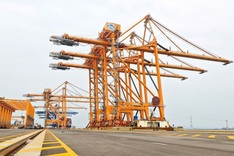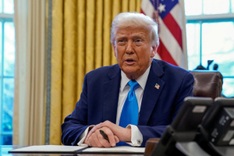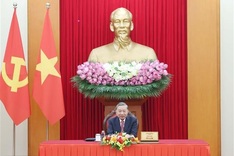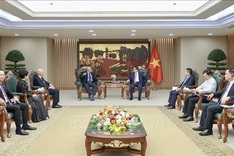“It will be a great deal of cooperation between our two countries,” trump wrote on Truth Social after his July 2 phone call with Party General Secretary To Lam of Vietnam.
“Vietnam will pay the United States a 20% tariff on any or all goods sent into our Territory, and a 40% tariff on any Transshipping. In return, Vietnam will do something that they have never done before, give the United States of America total access to their trade market for trade. In other words, they will open their market to the United States meaning we will be able to sell our products at zero tariff,” he wrote, describing the trade deal with Vietnam as an absolute pleasure.
During their earlier phone call, Lam and Trump expressed satisfaction with the positive development of Vietnam - US relations and welcomed the two sides’ agreement on a statement regarding a reciprocal, fair, and balanced trade framework.
Trump appreciated Vietnam’s commitment to granting preferential market access for US goods, including large-engine automobiles, and pledged to significantly reduce retaliatory tariffs on many Vietnamese exports.
Lam proposed that the US soon recognise Vietnam as a market economy and lift export restrictions on certain high-tech products.
Both leaders agreed to promote the Comprehensive Strategic Partnership by enhancing high-level exchanges and cooperation in key breakthrough areas such as science and high technology.
On this occasion, the Vietnamese leader reiterated his invitation for the US President and the First Lady to visit Vietnam, and both expressed their desire to meet again soon.
Positive market reaction
Major media outlets such as Reuters, Financial Times, Bloomberg and Nikkei simultaneously reported on the new trade agreement reached between the US and Vietnam, marking a significant milestone in international trade relations, with substantial implications for both economies and the global supply chain.
The Financial Times emphasised that Vietnam is one of the few countries to have secured a trade agreement with the US, highlighting the country’s growing stature on the global trade map at a time when many of America’s trading partners are racing to reach similar deals.
Media outlets are especially focused on the agreement's impact on regional supply chains and market reactions.
CNN noted markets reacted positively to the trade deal between the US and Vietnam, citing a sharp rise in the share prices of major firms that rely on supply chains in Vietnam, including Nike, Lululemon, and Columbia Sportswear, following Trump’s announcement of the trade deal.
CNBC also quickly updated market responses on Wall Street. The S&P 500 rose by 0.3%, while the Nasdaq Composite increased by 0.7%. The Dow Jones Industrial Average climbed 48 points, or 0.1%. Stock of Nike, a firm that manufactures about half of its footwear in Vietnam and China, rose by 3% after Trump’s announcement.
Key timeline
On April 2, the Trump administration announced a series of retaliatory tariffs on exports from dozens of countries, including a 46% tariff on Vietnamese goods. One week later, President Trump declared a 90-day suspension of these tariffs for 75 countries, including Vietnam. During this period, Vietnamese goods exported to the US will be subject to only a 10% tariff, instead of the previously planned 46%.
The Vietnamese Ministry of Foreign Affairs welcomed the decision, calling it a “positive step” that provides a favourable window for both sides to negotiate a reciprocal and balanced trade agreement.
Vietnam and the US had since conducted three rounds of negotiations, and after the third round in June they both said they had narrowed the gap.
On June 11, Trump indicated that he was open to considering an extension to the July 8 deadline for imposing new tariffs, in order to finalise trade talks with several countries.
Speaking to the press at the John F. Kennedy Centre for the Performing Arts before the performance of Les Misérables, Trump noted the US was currently negotiating with around 15 economies, including the Republic of Korea, Japan, and the European Union.
He also disclosed that in the next one to two weeks, the US would send letters to several economies proposing terms for trade agreements. Each country will have the right to accept or reject these proposals.




















